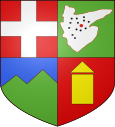Marlens
| Marlens | ||
|---|---|---|

|
|
|
| local community | Val de Chaise | |
| region | Auvergne-Rhône-Alpes | |
| Department | Haute-Savoie | |
| Arrondissement | Annecy | |
| Coordinates | 45 ° 46 ′ N , 6 ° 21 ′ E | |
| Post Code | 74210 | |
| Former INSEE code | 74167 | |
| Incorporation | January 1, 2016 | |
| status | Commune déléguée | |
 Town view - Marlens |
||
Marlen is a commune Déléguée in the French commune of Val de Chaise with 976 inhabitants (as of January 1 2017) in the department of Haute-Savoie in the region of Auvergne Rhône-Alpes .
geography
Marlens is located at 461 m , northeast of Faverges , about twelve kilometers north of the city of Albertville (as the crow flies). The village extends in a wide valley of the Chaise , which separates the Bornes Alps in the north from the Bauges massif in the south.
In addition to the actual town center, Marlens also included various hamlet settlements and farms, including:
- Ombre ( 500 m ) slightly elevated on the southern edge of the valley furrow
- Thermesay ( 470 m ) in the valley of the Chaise
- Le Villard ( 490 m ) north of Marlens
- La Côte-de-Marlens ( 960 m ) on the ridge west of the Col de l'Epine
Neighboring towns of Marlens are Serraval and Le Bouchet-Mont-Charvin in the north, Ugine in the east, Marthod and Cons-Sainte-Colombe in the south and Saint-Ferréol in the west.
history
The first written mention of Marlens dates from the year 867 under the name Villa Marlindam , when King Lothar of Lorraine donated the area to his wife Theutberga. The place name goes back to the Burgundian personal name Mârila . With the suffix -ens it means something like that of the people of Mârila.
The municipality of Marlens was merged with the former municipality of Cons-Sainte-Colombe with effect from January 1, 2016 and merged to form the Commune nouvelle Val de Chaise . It belonged to the Arrondissement of Annecy and the Canton of Faverges .
Attractions
The parish church of Saint-Victor et Saint-Ours was built from 1867 to 1868 in the neo-Gothic style. In the old town center, numerous houses in the typical Savoyard style have been preserved.
population
| Population development | |
|---|---|
| year | Residents |
| 1962 | 624 |
| 1968 | 616 |
| 1975 | 637 |
| 1982 | 609 |
| 1990 | 656 |
| 1999 | 699 |
| 2004 | 761 |
In the course of the 19th and 20th centuries, the number of inhabitants decreased continuously due to strong emigration (in 1861 there were still 807 inhabitants in Marlens). However, the population has increased again since the early 1980s.
Economy and Infrastructure
Until well into the 20th century, Marlens was a village dominated by agriculture and alpine farming . Today there are various small business enterprises. Several new businesses have also set up shop along the main street. Many workers are commuters who work in the larger towns in the area.
The village is very well developed in terms of traffic. It is on the main N508 road from Annecy to Albertville. Other road connections exist with Cons-Sainte-Colombe and Le Bouchet. The closest connection to the A430 motorway is around 17 km away. Marlens owned a train station on the Albertville to Faverges line, which has since been closed.
